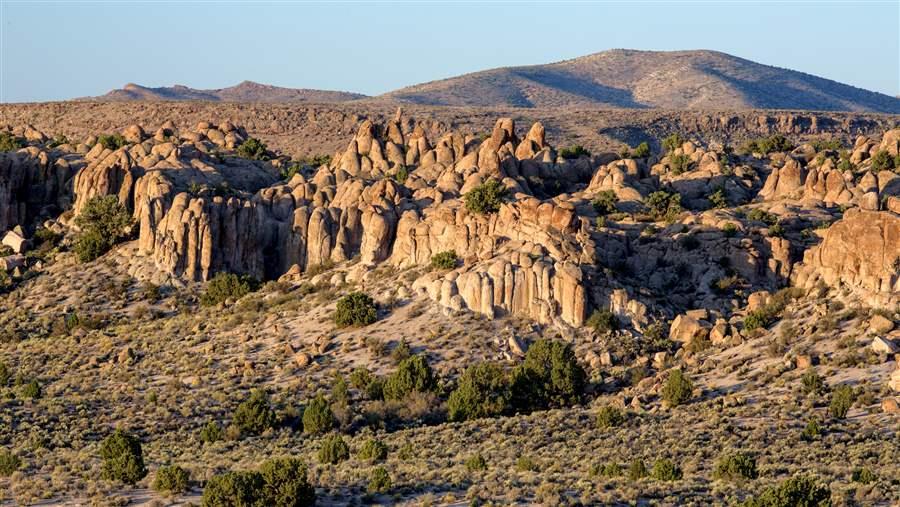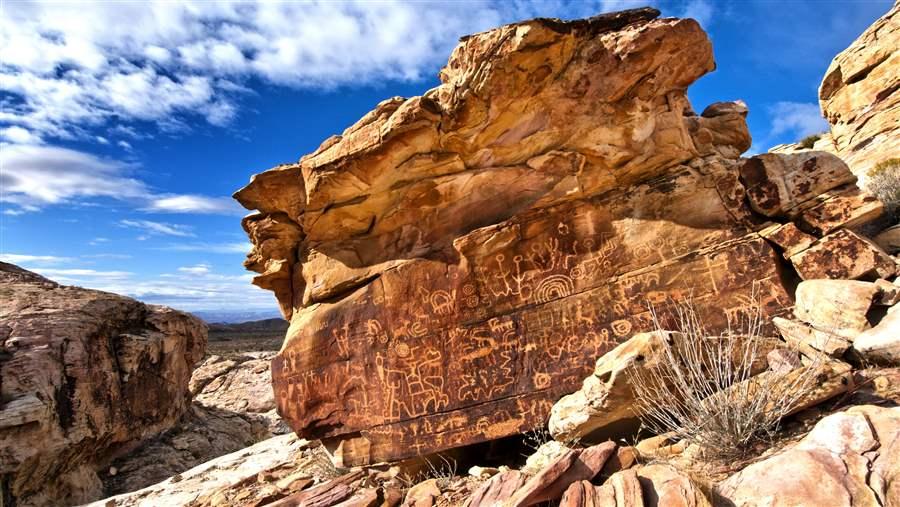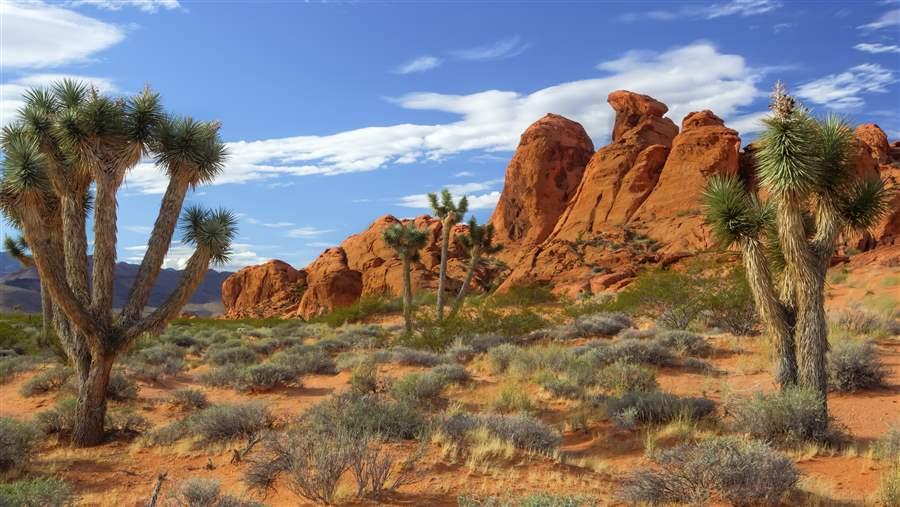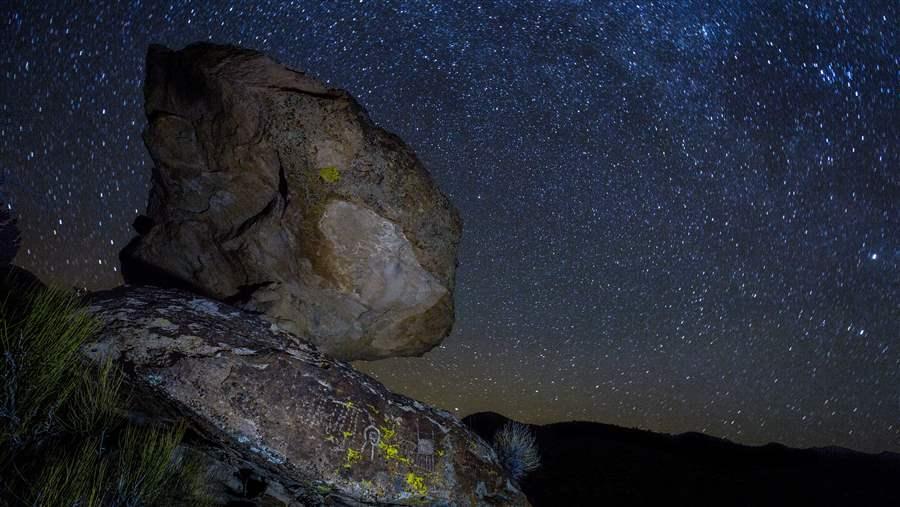Monuments Showcase Nevada’s Natural, Cultural, and Historical Splendor
Gold Butte and Basin and Range shine beneath star-filled skies and desert sunsets
Update: The period for public input on the Trump administration’s national monument review closed July 10 with more than 2 million comments submitted. Interior Secretary Zinke has until Aug. 24 to present his recommendations on the monuments to President Trump.
Southern Nevada is known as a mecca for those seeking bright lights and big-city entertainment. Nowhere does “big” quite like Las Vegas. But drive an hour or two north, and “big” takes on a completely different meaning. With the designation of two nearby national monuments, the region is increasingly being seen as a top destination for visitors seeking outdoor recreation, including quiet desert solitude and world-class dark skies.
The designation of the Basin and Range and Gold Butte national monuments in 2015 and 2016, through the Antiquities Act, preserved a significant piece of Nevada’s historical, cultural, and natural resources for all to experience. Unfortunately, the continued protection of these special public lands is in doubt: They are among 27 national monuments that the Trump administration is reviewing for possible revision or elimination.
The clear-cut case that led to the conservation of these areas hasn’t changed. They are rare, intact desert landscapes, essential habitat for many plants and animals, and home to vast treasures, including the delicate red rock formations in Gold Butte’s Little Finland area, and the Native American trails, rock shelters, and other archaeological sites throughout Basin and Range. And Nevadans support their preservation.
For years, tribes, elected officials, business owners, community groups, veterans, and outdoor enthusiasts called on our national leaders to safeguard these beloved landscapes.
The call to protect Gold Butte can be traced to at least 1998, when the Bureau of Land Management identified the region as an area of critical environmental concern. In February 2015, at a public meeting attended by more than 300 Southern Nevadans, participants delivered a clear message: Gold Butte and Basin and Range are unique areas that deserve permanent protection.
And that public support remains high. A 2017 Colorado College poll of Nevada voters found that 81 percent favored keeping existing national monument designations in place.

The Basin and Range region comprises desert valleys framed by a series of mountain ranges. It is one of the state’s most distinctive geographical features. But prior to the national monument designation, it was one of the least protected.
© Bob Wick/BLM
Basin and Range National Monument safeguards irreplaceable Native American rock art—the product of thousands of years of habitation by the Southern Paiutes and their forebears—and offers a glimpse into the lives of the earliest Americans. It also shields both upper- and lower-elevation habitat, a rarity in the West, for the mule deer, pronghorns, elk, and greater sage-grouse native to the area. And it shelters the area’s rare and sensitive plants—one of which, the White River catseye, is found nowhere else on the planet.

Petroglyphs and shelters dating back over 12,000 years can be found throughout Gold Butte. Vandals have damaged many artifacts, and without protection, countless priceless relics could be lost forever.
© Kurt Kuznicki
Gold Butte was formed by the same geologic forces that created Arizona’s Grand Canyon, and it is a huge draw for outdoor enthusiasts. Visitors flock here to hike, hunt, camp, bird-watch, cycle, and rollick along four-wheel-drive roads (the monument features over 500 miles of motorized recreation trails).
Safeguarding special places like Gold Butte and Basin and Range encourages tourism, increases revenue for local businesses, and creates a desirable place for people to live and work. A 2015 Applied Analysis study found that a national monument designation for Gold Butte could contribute nearly $2.7 million per year in economic activity and increase the number of jobs by 60 percent in the gateway city of Mesquite. This finding is supported by a West-wide study conducted by Headwaters Economics showing that communities near national monuments continue to thrive, with growth in employment, personal income, and per capita income that consistently outpaces the broader economy.

The Little Finland area can be accessed from the Gold Butte Backcountry Byway south of Mesquite, Nevada.
© Bob Wick/BLM
The communities around Gold Butte and Basin and Range have seen these benefits, and visitors from near and far have experienced the outdoor allure of Southern Nevada. It is now up to the Trump administration to preserve all the advantages of these two monuments for future generations.
Mike Matz directs The Pew Charitable Trusts’ U.S. public lands program.








